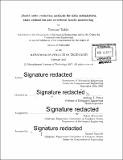Model order reduction methods for data assimilation : state estimation and structural health monitoring
Author(s)
Taddei, Tommaso
DownloadFull printable version (22.21Mb)
Alternative title
MOR methods for data assimilation : state estimation and structural health monitoring
Other Contributors
Massachusetts Institute of Technology. Department of Mechanical Engineering.
Advisor
Anthony T. Patera.
Terms of use
Metadata
Show full item recordAbstract
The objective of this thesis is to develop and analyze model order reduction approaches for the efficient integration of parametrized mathematical models and experimental measurements. Model Order Reduction (MOR) techniques for parameterized Partial Differential Equations (PDEs) offer new opportunities for the integration of models and experimental data. First, MOR techniques speed up computations allowing better explorations of the parameter space. Second, MOR provides actionable tools to compress our prior knowledge about the system coming from the parameterized best-knowledge model into low-dimensional and more manageable forms. In this thesis, we demonstrate how to take advantage of MOR to design computational methods for two classes of problems in data assimilation. In the first part of the thesis, we discuss and extend the Parametrized-Background Data-Weak (PBDW) approach for state estimation. PBDW combines a parameterized best knowledge mathematical model and experimental data to rapidly estimate the system state over the domain of interest using a small number of local measurements. The approach relies on projection-by-data, and exploits model reduction techniques to encode the knowledge of the parametrized model into a linear space appropriate for real-time evaluation. In this work, we extend the PBDW formulation in three ways. First, we develop an experimental a posteriori estimator for the error in the state. Second, we develop computational procedures to construct local approximation spaces in subregions of the computational domain in which the best-knowledge model is defined. Third, we present an adaptive strategy to handle experimental noise in the observations. We apply our approach to a companioni heat transfer experiment to prove the effectiveness of our technique. In the second part of the thesis, we present a model-order reduction approach to simulation based classification, with particular application to Structural Health Monitoring (SHM). The approach exploits (i) synthetic results obtained by repeated solution of a parametrized PDE for different values of the parameters, (ii) machine-learning algorithms to generate a classifier that monitors the state of damage of the system, and (iii) a reduced basis method to reduce the computational burden associated with the model evaluations. The approach is based on an offline/online computational decomposition. In the offline stage, the fields associated with many different system configurations, corresponding to different states of damage, are computed and then employed to teach a classifier. Model reduction techniques, ideal for this many-query context, are employed to reduce the computational burden associated with the parameter exploration. In the online stage, the classifier is used to associate measured data to the relevant diagnostic class. In developing our approach for SHM, we focus on two specific aspects. First, we develop a mathematical formulation which properly integrates the parameterized PDE model within the classification problem. Second, we present a sensitivity analysis to take into account the error in the model. We illustrate our method and we demonstrate its effectiveness through the vehicle of a particular companion experiment, a harmonically excited microtruss.
Description
Thesis: Ph. D., Massachusetts Institute of Technology, Department of Mechanical Engineering, 2017. Cataloged from PDF version of thesis. Includes bibliographical references (pages 243-258).
Date issued
2017Department
Massachusetts Institute of Technology. Department of Mechanical EngineeringPublisher
Massachusetts Institute of Technology
Keywords
Mechanical Engineering.